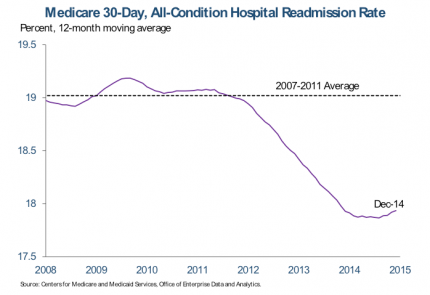Part 1: Identifying and Reducing Readmissions Rates
It’s no secret that America’s health care system needs intensive care. $180 billion is wasted every year on operational inefficiencies, and the condition is not improving. This is largely attributed to a fee-based system that incentivized volume over value.
In 2010, the Affordable Care Act made health care providers an offer they couldn’t refuse — a mandate to increase efficiency or feel the pain of stiff financial penalties. This ideology shifted the practice from fee for service to value-based care. Loved it or loathed it, health care providers are forced to play with the cards they were dealt with.
As with all illnesses, we begin with identifying the symptoms of a broken health care system, so we can follow through with a diagnosis and treatment. In this ten-part series, we will:
- Identify the most pressing challenges facing our health care system
- Address opportunities for improvements, and
- Make recommendations for enhancements
Finding solutions to fix our health care system won’t be resolved overnight, but it is prudent to focus on the elements that are causing inefficiencies. Then implement noninvasive solutions that are quick, intelligent, and cost-effective.
Challenge #1: Readmission
When our vehicle breaks down, we go to the mechanic to get it fixed. We expect our vehicle to function after our visit because it is part of a mechanic’s duty of care.
Similarly, a doctor’s obligation is to treat patients with a level of care that is consistent with the Hippocratic Oath. Unlike a machine, however, humans can’t be recalled. We either heal, deteriorate or perish. Readmissions are a serious threat to not only our health but to our health care system.
By far, Medicare bears the greatest burden of readmission and is the gold standard by which health care providers measure performance on. The three greatest preventable conditions for Medicare readmissions are:
- Congestive heart failure (24.5%)
- Septicemia (21.3%)
- Pneumonia (17.9%)
The conditions above cost hospitals over $4.3 billion. The government (and ultimately the taxpayer) foots 43% of our national health bill. Consequently, hospital reimbursements have recently been restructured under the Hospital Readmission Reduction Program (HRRP) in October 2012. The program focuses on patients who are readmitted within 30 days for high-cost or high-volume conditions and procedures. Specifically, heart attack, heart failure, pneumonia, chronic obstructive pulmonary disease (COPD), hip/knee replacement, and coronary artery bypass graft (CABG).
The Hospital Readmissions Reduction Program is designed to improve the quality of care by incentivizing the reduction of hospital readmissions and penalizing underperforming hospitals.
Since the initiation of the program, readmission rates have declined 1%, from more than 19.0% to less than 18.0%. Although this is an improvement, 50% of hospitals received readmission penalties of up to 3% for failing to meet the national readmission benchmark.
The financial cost is merely a symptom of the problem. Readmitted patients are preventable and increase demand for doctors who already have long waitlists. It also places a hindrance on society since patients are required to take repeated time off work or home care. In short, remitted patients are not given the proper treatment, which is simply poor quality of care.
Opportunity: Preventing Readmission
Readmission rates are calculated using discharge data for each hospital from the three years prior to the year in which the penalty is assessed. According to the Centers for Medicare & Medicaid Services (CMS), The two criteria for evaluating the impact of readmissions are volume and costs. To understand the impact of these variables, we need to look at the data that drives the numbers.
The average readmission rate for the top ten high volume conditions among Medicare beneficiaries is 19.6%. Simply put, nearly 1 in 5 patients return for preventable retreatments.
However, the quality of care is not solely dependent on hospital care. Hospitals serve patients of varying risk profiles. External factors such as socioeconomic status and demographics come into play and should be taken into consideration.
Despite these discrepancies, there are currently no provisions in the Health care Readmissions Reduction Program to account for these external factors. This could adversely (and often unfairly) impact the perception of a health care provider. These external data sets are largely unaccounted for but have a significant impact on patient readmission.
Recommendations: Patient-centered care.
There are ways to mitigate the risk of patient readmission. It begins with intimately knowing your patient. This may sound daunting at first, but it can be easier than you think.
The difference between a stranger and a loved one is data. With a friend, you know what appeals to them as much as what repulses them.
In the same way, health care providers can leverage data to determine whether a patient is considered at risk of readmission. But data itself is inert. It can’t predict and won’t prevent readmissions on its own. Therefore, health care providers need to aggregating and normalizing the data in order to understand the probability of readmission. Only then can you make accurate decisions.
Finally, patients need to be nurtured throughout their medical journey. Patient engagement is like following through on your golf or tennis swing. It takes practice, but it will certainly improve your game.
It starts with asking, “How have you been?” It’s simple, but not easy. Engaging your patients is very involving and can take tremendous resources from your admin staff. So new technologies such as CareSkore actively engages patients using artificial intelligence (A.I.) to prevent readmissions from occurring.
“A spoonful of sugar helps the medicine go down…”
Reducing readmissions isn’t a trivial task, but it is one that deserves attention. Readmissions prevent doctors from seeing fresh patients, disrupts the wellbeing of a patient, and drives costs to health care providers. There are early indicators that the health care industry is adopting methods to reduce readmissions. Not only because it is mandated by the government, but because prevention is better than treatment. Solutions are available to transform hospitals from a destination to a journey.


